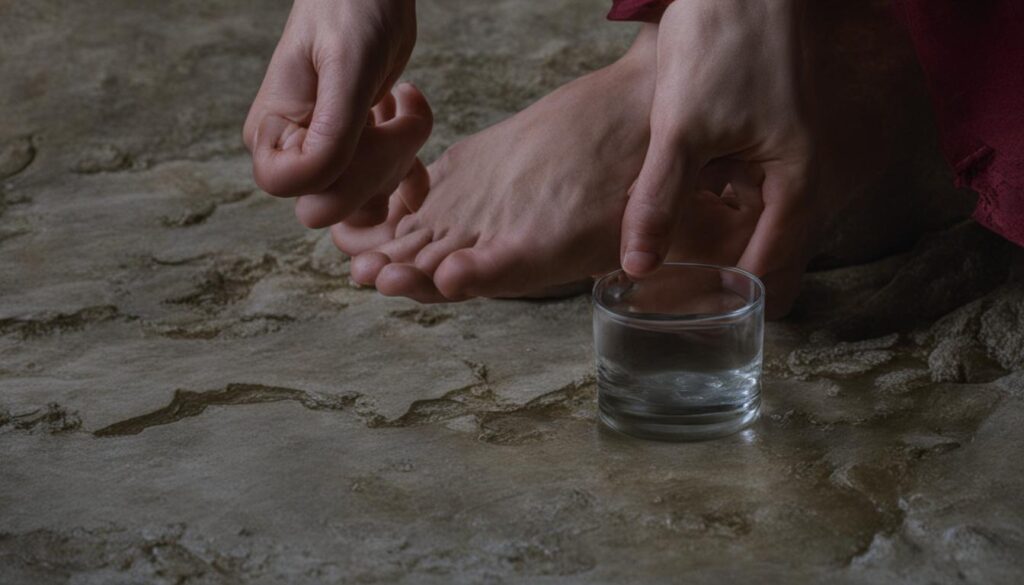Muscle cramps and spasms can cause sudden, painful contractions in the muscles of the hands, thumbs, feet, or toes. These spasms can be brief but intense and may be accompanied by symptoms such as cramping, fatigue, muscle weakness, numbness or tingling sensations, twitching, and uncontrolled rapid motions. While the exact cause of cramps in hands and feet is often unknown, possible factors include abnormal electrolyte or mineral levels, brain disorders, nerve damage, dehydration, hyperventilation, muscle overuse, pregnancy, thyroid disorders, vitamin D deficiency, and certain medications. To determine the cause, a healthcare provider may perform a physical exam and order tests such as blood and urine tests, hormone level tests, kidney function tests, and nerve conduction and electromyography tests. Treatment options depend on the underlying cause and may include hydration, vitamin or mineral supplements, medications, and lifestyle changes.
Key Takeaways:
- Cramps in hands and feet can be caused by a variety of factors including abnormal electrolyte or mineral levels, brain disorders, nerve damage, dehydration, hyperventilation, muscle overuse, pregnancy, thyroid disorders, vitamin D deficiency, and certain medications.
- A healthcare provider may perform physical exams and order tests to determine the cause of cramps in hands and feet.
- Treatment options for cramps in hands and feet depend on the underlying cause and may include hydration, supplementation, medications, and lifestyle changes.
- Maintaining proper hydration, nutrition, and exercise techniques can help prevent and manage cramps in hands and feet.
- Seek medical attention if cramps in hands and feet are severe, frequent, persistent, or accompanied by other concerning symptoms.
Electrolyte Imbalance: A Potential Culprit for Cramps in Hands and Feet
An abnormal balance of electrolytes or minerals in the body can contribute to muscle cramps, including those experienced in the hands and feet. Electrolytes such as potassium, calcium, and magnesium play essential roles in muscle function, and imbalances can cause muscles to spasm and cramp. Conditions such as chronic kidney disease and dialysis or the use of certain medications may disrupt electrolyte levels. Dehydration, which can result from inadequate fluid intake or excessive sweating, can also lead to electrolyte imbalances and subsequent muscle cramps.
To alleviate cramps in hands and feet caused by electrolyte imbalances, it is important to replenish electrolyte levels through hydration and, if necessary, supplementation. Maintaining proper fluid intake and ensuring a balanced diet rich in electrolyte-containing foods can help restore the body’s electrolyte balance and reduce the occurrence of muscle cramps. It is always advisable to consult with a healthcare provider for individualized guidance and recommendations.
Table: Electrolyte-Rich Foods
| Electrolyte | Foods High in Electrolytes |
|---|---|
| Potassium | Bananas, oranges, spinach, avocado |
| Calcium | Dairy products, leafy greens, almonds |
| Magnesium | Nuts, seeds, legumes, whole grains |
By incorporating electrolyte-rich foods into your diet, you can support your body’s electrolyte balance and potentially reduce the occurrence of cramps in your hands and feet. It is important to note that a balanced approach to nutrition and hydration is essential, and any significant dietary changes should be discussed with a healthcare provider.
Neurological Disorders and Nerve Damage: Potential Causes of Cramps in Hands and Feet
Neurological disorders and nerve damage can both contribute to the development of cramps in the hands and feet. Conditions such as Parkinson’s disease, multiple sclerosis, dystonia, and Huntington’s disease can affect the brain and nervous system, leading to muscle spasms and cramps. These disorders disrupt the normal communication between the brain and muscles, resulting in involuntary contractions and the sensation of cramping.
In addition to neurological disorders, damage to a single nerve or a group of nerves connected to the muscles can also cause cramping. This type of nerve damage, known as mononeuropathy or polyneuropathy, respectively, can occur due to various factors such as trauma, compression, or underlying medical conditions like diabetes. When the nerves are compromised, they can send abnormal signals to the muscles, resulting in cramps and discomfort.
Understanding the Role of Nerve Damage in Cramps
Nerve damage can disrupt the normal functioning of the muscles in the hands and feet, leading to cramps. The nerves provide the necessary signals for muscle contraction and relaxation, and when they are damaged, these signals can become irregular or overactive. This can cause the muscles to contract and cramp, creating the characteristic discomfort and pain.
Nerve damage can disrupt the normal functioning of the muscles in the hands and feet, leading to cramps.
It is important to note that cramps caused by neurological disorders or nerve damage are often chronic and may require ongoing management and treatment. In these cases, it is essential to work closely with healthcare professionals to develop a comprehensive treatment plan that addresses the underlying condition and provides relief from cramps.

If you experience hyperventilation, it’s important to focus on slow, controlled breathing techniques to help restore proper oxygen and carbon dioxide levels in the body.
By recognizing the potential triggers of dehydration and hyperventilation and taking steps to address them, you can reduce the frequency and severity of cramps in your hands and feet. Remember to stay hydrated, especially during physical activity or in hot weather, and practice deep breathing techniques to maintain a healthy balance of electrolytes and prevent muscle cramps.
Muscle Overuse and Pregnancy: Potential Factors for Cramps in Hands and Feet
Muscle overuse and pregnancy are two potential factors that can contribute to the development of cramps in the hands and feet. Engaging in repetitive movements or placing excessive stress on the muscles can strain them and lead to cramping. This is commonly experienced during sports or work activities where the same muscle groups are used repeatedly. It’s important to practice proper body mechanics and take breaks during physical activity to prevent muscle overuse and reduce the risk of cramps.
Pregnancy, especially during the third trimester, can also increase the likelihood of experiencing cramps in various parts of the body, including the hands and feet. The hormonal changes and increased physical demands on the body during pregnancy can lead to muscle spasms and cramps. It’s important for pregnant individuals to listen to their bodies, practice balanced exercise routines, and consult with their healthcare providers for guidance on managing cramps during pregnancy.
In summary, muscle overuse and pregnancy are potential factors that can contribute to cramps in the hands and feet. Practicing proper body mechanics, taking breaks during physical activity, and maintaining a balanced exercise routine can help prevent cramps associated with muscle overuse. Pregnant individuals should listen to their bodies, engage in suitable exercise, and consult with their healthcare providers for personalized guidance on managing cramps during pregnancy.
Thyroid Disorders and Vitamin D Deficiency: Possible Causes of Cramps in Hands and Feet
Thyroid disorders and vitamin D deficiency are among the potential causes of cramps in the hands and feet. Thyroid disorders, such as hypothyroidism or hyperthyroidism, can disrupt the normal functioning of various bodily systems, including muscle function. Imbalances in thyroid hormone levels can lead to muscle weakness, fatigue, and muscle cramps, including those experienced in the hands and feet. On the other hand, vitamin D deficiency, which is often associated with inadequate sun exposure or dietary intake, can also contribute to muscle cramps. Vitamin D plays a role in calcium absorption and muscle function.
Managing these underlying conditions is vital in alleviating cramps in hands and feet caused by thyroid disorders and vitamin D deficiency. Individuals with thyroid disorders may require medical treatment to restore proper thyroid function through medication. Additionally, ensuring sufficient vitamin D levels through sunlight exposure and supplementation, if necessary, can help alleviate cramps in hands and feet caused by vitamin D deficiency. Consulting with a healthcare provider and following their recommended treatment plan is essential for effectively managing cramps associated with these conditions.
To provide a comprehensive overview, let’s explore the possible causes of cramps in hands and feet in the table below:
| Possible Causes | Description |
|---|---|
| Thyroid Disorders | Disruption in thyroid hormone levels can lead to muscle weakness, fatigue, and cramps in hands and feet. |
| Vitamin D Deficiency | Inadequate vitamin D levels can affect calcium absorption and contribute to muscle cramps in the hands and feet. |
By addressing and managing thyroid disorders and vitamin D deficiency, individuals can significantly reduce the occurrence of cramps in their hands and feet. It is important to work closely with a healthcare provider to ensure proper diagnosis, treatment, and ongoing management of these conditions. With appropriate care and attention, individuals can regain control over their muscle health and alleviate the discomfort caused by cramps in the hands and feet.
Medication Use: Possible Link to Cramps in Hands and Feet
The use of certain medications may be associated with muscle cramps in the hands and feet. While medications can provide relief from various ailments, they can also have side effects, including muscle cramps. Certain medications may disrupt electrolyte balance or cause imbalances that contribute to muscle cramps.
If you suspect that medication use may be contributing to cramps in your hands and feet, it is important to consult with your healthcare provider. They can evaluate your medication regimen and make any necessary adjustments to help alleviate the cramps.
Common Medications that May Cause Cramps in Hands and Feet
| Medication | Possible Side Effect |
|---|---|
| Diuretics (water pills) | Electrolyte imbalances |
| Statins (cholesterol-lowering drugs) | Muscle pain and cramps |
| Antidepressants | Muscle spasms and stiffness |
| Antipsychotics | Muscle rigidity and dystonia |
| Blood pressure medications (e.g., ACE inhibitors, beta-blockers) | Electrolyte imbalances |
| Anticonvulsants (seizure medications) | Muscle cramps and spasms |
It is essential to provide your healthcare provider with a complete list of all medications you are taking, including over-the-counter drugs, herbal supplements, and vitamins. This information will help them identify any potential links between your medication use and the cramps in your hands and feet.
Remember, do not stop or adjust your medication regimen without consulting your healthcare provider first. They will be able to guide you on the appropriate course of action based on your individual circumstances.
Managing Cramps in Hands and Feet: Treatment and Prevention Strategies
When it comes to managing cramps in the hands and feet, it’s essential to address the underlying cause and implement strategies to prevent their occurrence. The treatment options for cramps vary depending on the specific cause, but there are some common approaches that can help alleviate the discomfort and reduce the frequency of cramps.
Hydration and Electrolyte Balance
Staying adequately hydrated is crucial in preventing cramps in the hands and feet. Dehydration can disrupt electrolyte levels in the body, leading to muscle spasms and cramps. Drinking enough water throughout the day can help maintain proper hydration and electrolyte balance. In some cases, supplementing with electrolytes such as potassium, calcium, and magnesium may be beneficial, especially for those who engage in intense physical activities or sweat excessively.
Stretching and Exercise
Incorporating regular stretching exercises into your daily routine can help prevent cramps by improving muscle flexibility and reducing muscle tension. Stretching the muscles in your hands and feet before engaging in physical activity can be particularly beneficial. Additionally, maintaining a balanced exercise routine that includes strength training and cardiovascular exercises can help strengthen the muscles and improve overall muscle function, reducing the risk of cramps.
Lifestyle Modifications
Adopting certain lifestyle modifications can also contribute to the prevention and management of cramps. Avoiding excessive alcohol consumption and reducing or eliminating caffeine intake can help prevent dehydration and minimize the risk of cramps. It’s also important to maintain a balanced diet that includes essential minerals and vitamins, such as potassium, calcium, and vitamin D, which play a crucial role in muscle function. If necessary, your healthcare provider may recommend dietary changes or supplementation to ensure adequate nutrient intake.
Being mindful of your body and taking breaks during physical activities or repetitive movements can also help prevent muscle overuse and reduce the likelihood of cramps. Practicing techniques to manage stress and anxiety, such as deep breathing exercises or meditation, can also be beneficial in preventing cramps triggered by hyperventilation.
Overall, managing cramps in the hands and feet requires a comprehensive approach that addresses the underlying causes and incorporates preventive measures into your daily routine. By staying hydrated, exercising regularly, making lifestyle modifications, and seeking medical advice when necessary, you can effectively manage and reduce the occurrence of cramps, allowing you to enjoy your daily activities without discomfort.
When to Seek Medical Care for Cramps in Hands and Feet
If you experience muscle cramps in your hands and feet, it’s important to know when to seek medical care. While most cramps are harmless and can be managed with self-care, there are certain situations that warrant medical attention. Pay attention to the following signs and symptoms:
- Severe discomfort: If your cramps are extremely painful and interfere with your ability to perform daily activities, it’s recommended to consult with a healthcare provider.
- Leg swelling, redness, or skin changes: If you notice any unusual swelling, redness, or changes in the skin accompanying your cramps, seek medical evaluation.
- Muscle weakness: If cramps in your hands and feet are accompanied by muscle weakness, it may indicate an underlying issue that needs medical attention.
- Frequent or persistent cramps: If you experience cramps on a regular basis or if they don’t improve with self-care measures, it’s advisable to consult with a healthcare provider for further evaluation.
- Disruption of daily activities or sleep: If cramps in your hands and feet interfere with your ability to perform daily tasks or disrupt your sleep patterns, seeking medical care is recommended.
By recognizing these signs and symptoms, you can determine when it’s necessary to consult with a healthcare provider for further evaluation and appropriate treatment.
Conclusion
In conclusion, dealing with cramps in the hands and feet can be a challenging and uncomfortable experience. However, by understanding the potential causes and implementing appropriate strategies, individuals can effectively manage and prevent these muscle cramps.
Factors such as electrolyte imbalances, neurological disorders, muscle overuse, pregnancy, thyroid disorders, vitamin D deficiency, and medication use can contribute to cramping in the hands and feet. By addressing these underlying causes, individuals can find relief and regain control over their lives.
Managing cramps in the hands and feet involves staying hydrated, maintaining a balanced diet, practicing proper exercise techniques, and seeking medical care when necessary. By incorporating these strategies into daily life, individuals can alleviate and prevent cramps, allowing for a better quality of life overall.
FAQ
What are the causes of cramps in hands and feet?
Possible causes of cramps in hands and feet include electrolyte imbalance, neurological disorders, muscle overuse, dehydration, hyperventilation, pregnancy, thyroid disorders, vitamin D deficiency, and medication use.
Can an electrolyte imbalance contribute to cramps in hands and feet?
Yes, an abnormal balance of electrolytes, such as potassium, calcium, and magnesium, can disrupt muscle function and contribute to cramps in hands and feet.
Can neurological disorders and nerve damage cause cramps in hands and feet?
Yes, conditions like Parkinson’s disease, multiple sclerosis, dystonia, and nerve damage can affect the brain and nervous system, leading to muscle spasms and cramps in the hands and feet.
Are dehydration and hyperventilation potential triggers for cramps in hands and feet?
Yes, both dehydration and hyperventilation can disrupt electrolyte balance and lead to muscle cramps in the hands and feet.
Can muscle overuse and pregnancy contribute to cramps in hands and feet?
Yes, engaging in repetitive movements, placing excessive stress on the muscles, and pregnancy can increase the risk of experiencing cramps in the hands and feet.
Can thyroid disorders and vitamin D deficiency cause cramps in hands and feet?
Yes, imbalances in thyroid hormone levels and insufficient vitamin D levels can affect muscle function and lead to cramps in hands and feet.
Is there a link between medication use and cramps in hands and feet?
Certain medications may disrupt electrolyte balance or cause imbalances that contribute to muscle cramps in the hands and feet.
How can cramps in hands and feet be managed and prevented?
Management and prevention strategies may include staying hydrated, maintaining proper nutrition, practicing appropriate exercise techniques, and seeking medical care when necessary.
When should I seek medical care for cramps in hands and feet?
It is advisable to seek medical care if you experience severe discomfort, leg swelling, redness or skin changes with cramps, muscle weakness, frequent or persistent cramps that do not improve with self-care, or cramps that interfere with daily activities or disrupt sleep.




